what does turning to a shoulder mean on a lathe
In this article, you volition learn about what are the unlike types of lathe machine operations performed on the lathe automobile.
Lathe Automobile Operations
A lathe is a machine that rotates the workpiece about an axis to perform different operations such as turning, facing, taper turning, knurling, grooving, departing off, thread cutting, reaming, etc.

Permit'due south discuss all lathe motorcar operations i by 1 as follows.
To perform different lathe car operations on a lathe, the workpiece may be supported and driven by whatsoever i of the following methods:
- Workpiece held between centres and tool driven past carriers and catch plates.
- Workpiece held on a mandrel which is supported betwixt centres and driven by carriers and catch plates.
- Held and driven by chuck with the other stop supported on the tailstock middle.
- Held and driven by a chuck or a faceplate or an angle plate.
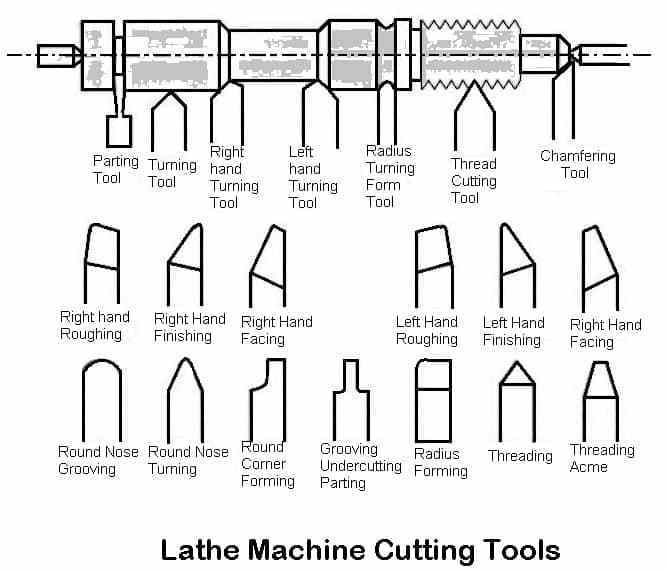
The above methods of holding the work may be classified under 2 heading:
- Workpiece held between centres.
- Workpiece held past a chuck or any other fixtures.
Types of Lathe Automobile Operations
The lathe machine operations are classified into three master categories and are every bit follows.
Following are the Lathe motorcar operations washed either past holding the workpiece between centres or past a chuck:
- Turning Operation
- Plain or Straight Turning
- Rough Turning
- Shoulder Turning
- Taper Turning
- Eccentric Turning
- Facing Operation
- Chamfering Operation
- Knurling Operation
- Thread cut Operation
- Filing Operation
- Polishing Functioning
- Grooving Operation
- Spinning Operation
- Spring Winding
- Forming
Lathe machine operations which are performed by property the work by a chuck or a faceplate or an angle plate are:
- Drilling
- Reaming
- Boring
- Counterboring
- Taper deadening
- Tapping
- Undercutting
- Internal thread cutting
- Parting-off
The functioning which is performed past using special attachments are:
- Grinding
- Milling
Read Likewise about Lathe Automobile:
- Lathe Machine: Parts, Types, Accessories, Attachments
- vii Types Of Lathe Machine Chucks with [Images]
- Cutting speed, Feed, Depth of cut, Machining time in lathe machine
- 14 Dissimilar Types of Lathe Cut Tools
1. Operations Done by Belongings Workpiece Between Centres
Turning:
It is the most mutual blazon of operation in all lathe machine operations. Turning is the operation of removing the excess material from the workpiece to produce a cylindrical surface to the desired length.
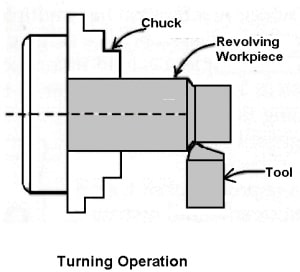
The job held between the middle or a chuck and rotating at a required speed. The tool moves in a longitudinal direction to give the feed towards the headstock with proper depth of cut. The surface finish is very good.
ane. Straight Turning:
The workpiece is held on the chuck and it is made to rotate virtually the axis, and the tool is fed parallel to the lathe axis. The straight turning produces a cylindrical surface by removing excess metal from the workpiece.
2. Rough Turning:
It is the process of removal of excess fabric from the workpiece in minimum fourth dimension by applying high rate feed and heavy depth of cut. in crude turning the boilerplate depth of cut 2mm to 4mm can exist given and feed is from 0.iii to 1.5mm per revolution of the piece of work.
3. Shoulder Turning:
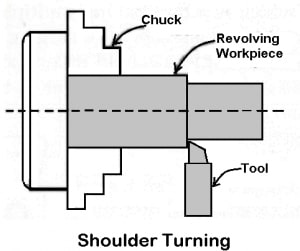
When a workpiece has unlike diameters and is to exist turned, the surface forming steps from one diameter to the other is called the shoulder, and machining this part of the workpiece is chosen shoulder turning.
Eccentric turning:
When a cylindrical surface two separate axis of rotation, with the beginning centrality, is offset to the other centrality then such a workpiece is machined past the operation called eccentric turning. Here 3 sets of centre holes are drilled.
By holding the workpiece at these 3 centres the machining operation for each of the surface can exist completed.
Taper Turning:
- A "taper" is the uniform increase or subtract in the diameter of the workpiece and measured along with its length.
- Taper turning means to produce a conical shape by a gradual reduction in diameter from a cylindrical workpiece.
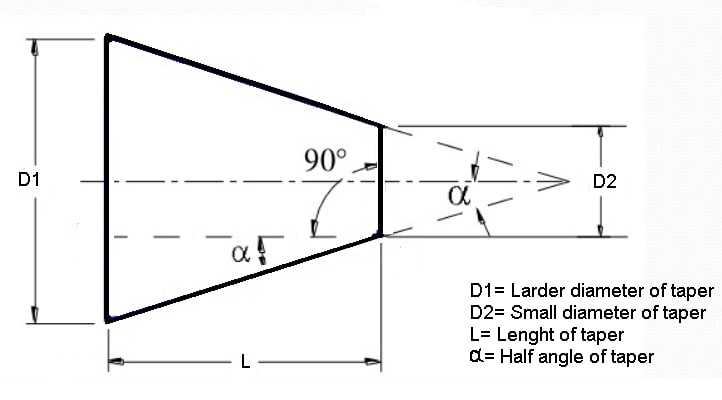
The amount of taper in the workpiece is usually specified on the basis of the deviation in diameter of the taper to its length. It is known as a cone and it is indicated by the alphabetic character M.
It has the formula Thou = D-d / one to produce the taper on the workpiece.
- D = Larger diameter of taper.
- d = Small bore of taper.
In the instance of a lathe, the taper on a given workpiece is obtained by tuning the task and feeding the tool at an angle to produce a gradual increase or decrease in the bore of the workpiece.
- The two important types of tapers are,
- "More taper" here, the angle is very small and varies from ane.4 to 1.5°.
- "Metric taper" is available in vii standard sizes with standard taper angles.
- Methods of taper turning,
- Form tool method
- Combined feeds method
- Chemical compound rest method or swivelling compound rest method
- Tailstock set over method
- Taper turning attachment method
one. Form tool method
Hither the taper length obtain is equal to the width of the form tool. To obtain the required size of the taper the grade tool is fed slowly direct into the workpiece by operating the cross slide perpendicular to the lathe axis.
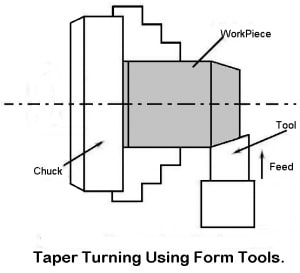
This is the simplest method of taper turning. It is limited to obtain modest taper length such as chamfering the side of the workpiece. The method is washed at a faster rate.
2. Combined feeds method
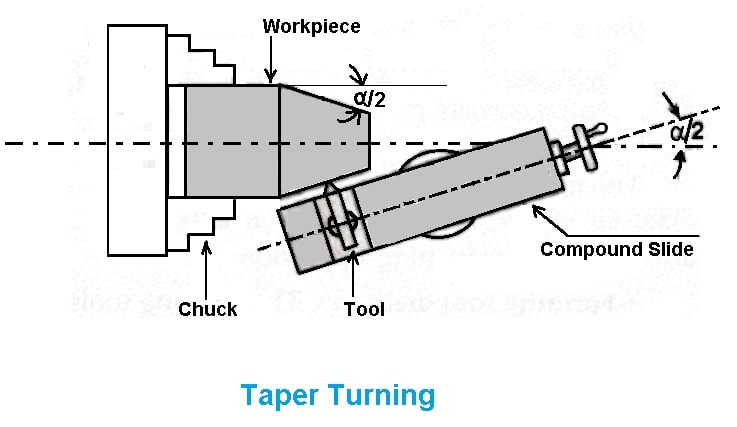
The combined feed is made with the movement of a tool in longitudinal and lateral direction simultaneously while moving the workpiece.

The taper, which we are going to obtain, is equal to the resultant to the magnitude of the longitudinal and lateral feeds. Irresolute the feeds rates in both directions can change the direction and the taper bending.
3. Compound rest swivel method
Here the workpiece rotates and the cutting tool is fed at an angle by swivelled compound balance. The base of the chemical compound residue is graduated in degrees.
The taper angle is the bending at which the compound rest to be rotated is calculated by using the formula tanα = D-d / 21, where, D= bigger diameter, d = smaller bore, l = length of the workpiece.
Compound residuum can be swivelled to the required angle α. One time the compound residuum is set to a
4.Taper turning attachment method
- This method is similar to the compound rest method.
- Hither the job or workpiece rotates and the tool is fed at the taper angle α.
- In this, organization, which has guide block graduated in degrees, with the help of this the block can be required taper angle to the lathe axis.
- The taper bending is calculated similarly to the
compound balance method using the formula: tanα = D-d / 21.
Advantages of taper turning attachment:
- Internal tapers can be obtained accurately.
- large size tapers can be easily obtained.
- One time the zipper is set the taper turning operation can exercise at a faster rate.
- Past setting the taper bending to 'zip' we tin can carry out plain turning.
Disadvantages of taper turning zipper:
- It requires boosted mounting facilities.
- Fitting and removing attachment consume more fourth dimension.
- The attachment has to accept big forces.
Tailstock set over method:
Here the workpiece on the chore is tilted at the required taper bending. The tool is fed parallel to the centrality.
The tilting of the workpiece or the task to the required taper angle is achieved by the motion of the tailstock with the assistance of tailstock prepare over the screw. This method is useful for minor tapers.
Facing:
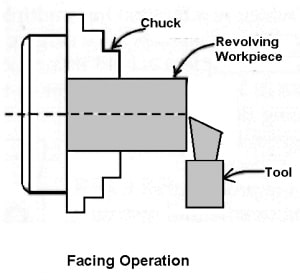
It is an operation of reducing the length of the workpiece past feeding the perpendicular to the lathe axis. This operation of reducing a flat surface on the end of the workpiece. For this performance, regular turning tool or facing tool may apply. The cutting edge of the tool should prepare to the same pinnacle as the center of the workpiece.
- Facing consist of 2 operations
- Roughing: Here the depth of cut is 1.3mm
- Finishing: Here the depth of cut is 0.2-0.1mm.
Chamfering operation:
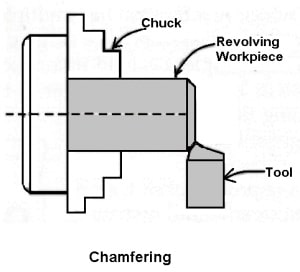
It is the operation of getting a bevelled surface at the edge of a cylindrical workpiece. This operation is done in case of bolt ends and shaft ends. Chamfering helps to avert damage to the sharp edges and protect the operation getting hurt during other operations. Chamfering on bolt helps to screw the nut easily.
Knurling operation:
It is an operation of obtaining a diamond shape on the workpiece for the gripping purpose. This is done to provide a better gripping surface when operated by hands. It is done using a knurling tool. The tool consists of a set of hardened steel roller, and it is held rigidly on the toolpost.
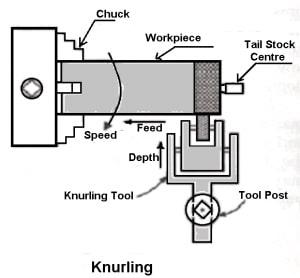
Knurling is done at the lowest speed available on a lathe. It is done on the handles and besides in case of ends of gauges. The feed varies from 1 to 2 mm per revolution. Ii or 3 cuts may be necessary to requite the full impression.
Thread cutting:
Information technology is the important operation in the lathe to obtain the continuous "helical grooves" or " threads''.
When the threads or helical grooves are formed on the out surface of the workpiece is called external thread cutting. When the threads or helical grooves are formed on the inner surface of the workpiece is called internal thread cutting. The workpiece is rotating betwixt the two centres i.due east., live center and dead middle bone the lathe.
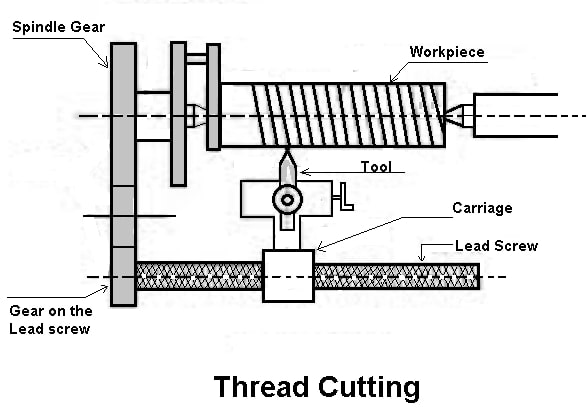
Hither the tool is moved longitudinally to obtain the required type of the thread. When the tool is moved from right to the left we get the left-hand thread. Similarly, when the tool is moved from left to the correct nosotros get the right-hand thread.
Here the motility of the carriage is provided by the pb screw. A pair of change gears drives the lead spiral and by rotating the handle the depth of cut tin can exist controlled.
Filling:
It is the finishing operation performed after turning. This is done on a lathe to remove burrs, sharp corners, and feed marks on a workpiece and also to bring it to the size by removing the very modest corporeality of metal.
The operation consists of passing a flat single-cutting file over the workpiece which revolves at a high speed. The speed is normally twice that of turning.
Polishing:
This operation is performed subsequently filing to amend the surface quality of the workpiece. Polishing with successively finer grades of emery cloth later filing results in a very smooth, bright surface. The lathe is run at loftier speeds from 1500 to 1800m per min, and oil is used on the emery textile.
Grooving:
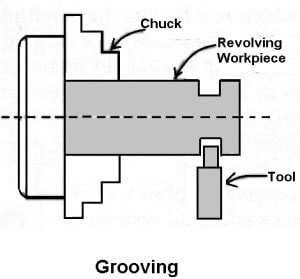
It is the process of reducing the diameter of a workpiece over a very narrow surface. It is done by a groove tool. A grooving tool is like to the departing-off tool. It is often done at the end of a thread or adjacent to a shoulder to leave a pocket-sized margin.
Spinning:
it is the process of forming a thin sheet of metal by revolving the chore at high speed and pressing it against a headstock spindle. Back up is likewise given from the tailstock end.
Bound Winding:
Spring winding is the process of making a coiled spring by passing a wire effectually a mandrel which is revolved on a chuck or betwixt centers. A small hole is provided on the steel bar, which is supported past Tool Post and the wire is allowed to pass through it.
Forming:
It is the process of turning a convex, concave, or of whatever irregular shape. Form-turning may be accomplished by the following method:
- Using a forming tool.
- Combining cantankerous and longitudinal feed.
- Tracing or copying a template.
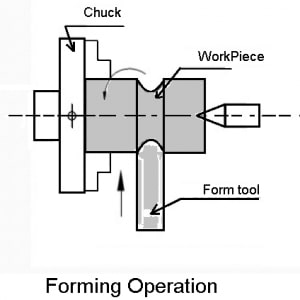
Forming tools are non supposed to remove much of the fabric and is used mainly for finishing formed surfaces. Generally, ii types of forming tools are used directly and circular. The direct type is used for wider surface and the circular blazon for narrow surfaces.
2. Operations Done By Holding The Work Past A Chuck
Lathe machine operations performed by holding the piece of work by a chuck or a faceplate or an bending plate are:
Drilling:
Drilling is the operation of producing a cylindrical hole in a workpiece. It is done by a rotating tool, the rotating side of the cutter, known equally a drilling drill. In this operation, The workpiece is revolving in a chuck or a faceplate and the drill is held in the tailstock drill holder or drill chuck.
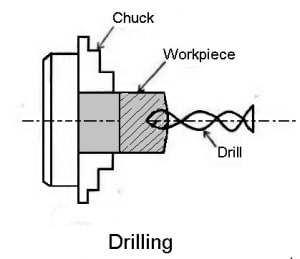
The feeding is adopted is affected by the movement of the tailstock spindle. This method is adopted for the drilling of regular-shaped workpiece.
Reaming:
Reaming is the functioning of finishing and sizing a hole which has been already drilled or bored. The tool is used is chosen the reamer, which has multi-plate cutting edges.
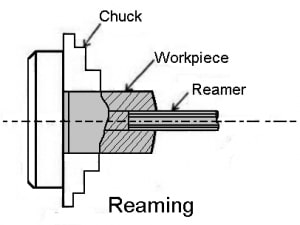
The reamer is held on the tailstock spindle, either directly or through a drill chuck, and is held stationary while the work is revolved at a very tiresome speed.
Boring:
Tedious is the operation of enlarging the hole which is already drilled, punched or forged. It cannot produce a hole. Boring is similar to the external turning operation and tin can be performed in a lathe. In this functioning, the workpiece is revolved in a chuck or a faceplate and the tools which are fitted to the tool post is fed into the work.
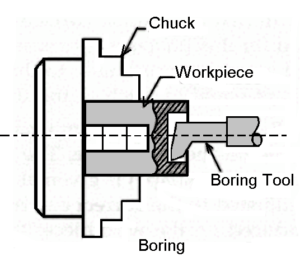
It consists of a boring bar having a single-point cutting tool that enlarges the hole. It also corrects out of the roundness of a pigsty. This method adopted for boring minor-sized works only. The speed of this process is slow.
Counterboring:
Counterboring is the performance of enlarging the end of the pigsty through a sure distance. It is similar to shoulder piece of work in external turning.
The operation is like to wearisome and plain dull tools or a counterbore may be used. The tool is used called a counterbore. The speed is slightly less than drilling.
Taper Wearisome:
The principle of turning a tapered hole is like to the external taper turning operation and is completed by rotating the work on a chuck or a faceplate. The feeding tool is at an angle to the axis of rotation of the workpiece.
A boring tool is mounted on the tool post and past swivelling the compound slide to the desired angle, a short taper hole is machined by mitt feeding.
Tapping:
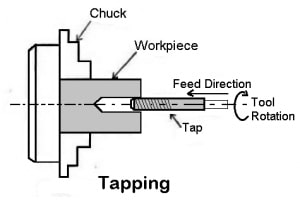
Borer is the operation of cutting internal threads of small diameter using a multipoint cutting tool called the tap. In a lathe, the work is mounted on a chuck or on a faceplate and revolved at a very slow speed. A tap of the required size held on a special fixture is mounted on the tailstock spindle.
Undercutting:
Undercutting is like to a grooving performance when performed inside a hole. It is the process of tedious a groove or a large hole at a fixed distance from the cease of a hole.
This is similar to the boring performance, except that a square nose
iii. Lathe Operations Done By Using Special Attachments
Lathe machine operations are performed past using special attachments:
Milling:
Milling is the functioning of removing metal past feeding the work against a rotating cutter having multiple cutting edges.
For cutting keyways or grooves, the work is supported on the cross-slide by a special attachment and fed against a rotating milling cutter held by a chuck. The depth of cut is given by vertical adjustment of the piece of work provided by the attachment.
The depth of cutting is given by verticle aligning of the work provided by the attachment. The feeding movement is provided by the carriage and the vertical motion of the cutter is bundled in the attachment.
Grinding:
Grinding is the operation of removing the metal in the course of minute chips past feeding the work against a rotating abrasive wheel known as the grinding bike.
Both internal and external surface of a workpiece may be footing past using a special attachment mounted on the cross slide. For the grinding external surface, the piece of work may be revolved between centres or on a chuck. For internal grinding, the piece of work must exist revolved on a chuck or faceplate.
The feeding is done by the railroad vehicle and the depth of cutting is provided by the cross slide. Grinding is performed in a lathe for finishing a job, sharpening a cutter, or sizing a workpiece after it has been hardened.
Conclusion:
As we discussed lathe has a broad range of applications in manufacturing industries. Performing any operation on the lathe is much easier than other machines and learning about this machine is every bit easier.
That is information technology, thanks for reading. If you similar our article on "lathe machine operations" then please share with your friends. If you have whatsoever questions near this topic ask in the comments.
Subscribe to newsletter to get latest updates through e-mail.
Now you tin Download the free PDF file from below:
Read Next:
- Drilling auto The complete guide – It's Types, Operations and more than [with pictures]
- Types of lathe machine.
Image credit for lathe machine: http://engineering.myindialist.com/2009/working-principle-of-lathe-automobile/
Source: https://www.theengineerspost.com/lathe-machine-operations/
0 Response to "what does turning to a shoulder mean on a lathe"
Post a Comment